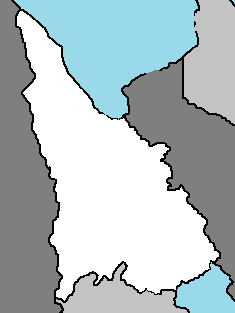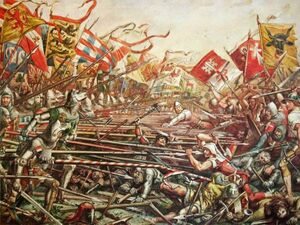Marcisia
The Principality of Marcisia | |
|---|---|
|
Flag | |
| Motto: Rich nation, strong army | |
 | |
| Capital | Veramento |
| Official languages | Latin Gaulish |
| Government | Unitary constitutional elective principality |
• Prince | Alexandre I |
| Establishment | |
• Cyrasenic Dynasties | c. X century BCE |
• Mycrasian Empire | 24 BCE |
• Feudal Confederation | 1243 |
• Marcisian Social State | 1929 |
• Republic | 1947 |
• Principality | 2021 |
| Population | |
• 2021 estimate | 25,417,100 |
| GDP (PPP) | estimate |
• Total | 499.192 billion |
• Per capita | 19,598 |
| Currency | Marcisian Mark |
Marcisia, formally the Principality of Marcisia, is a sovereign country in Central Adula, bordered by Kossmil to the east and Wyomia to the south. Veramento is the country's capital and largest city.
Marcisia is a unitary constitutional elective principality with Prince Alexandre I as the head of state and government. The Prince of Marcisia is elected for life by national popular vote.
The National Assembly is the highest legislative body and holds general elections every 4 years through first-past-the-post constituencies.
The executive power is lead by the Prince and his ministers. The ministers are exclusively selected by merit from the state bureaucracy. The head of government may dismiss any member of his cabinet but he doesn't possess the authority to appoint them. State bureaucracy choose their ministerial leadership by direct secret ballot.
Some scholars have described the Marcisian political system as a form of plebiscitary technocracy or technocratic democracy.
On 7 September 2021, Marcisia became a full member of the Coalition of Crown Albatross.
History
Early dynastic rule
The most archaic historical evidences from today's Marcisia are situated in the northern shore of Lake Ellin. Ceramic items, metal works, mosaics and specially tombs revail the way of life of the Cyrasenic culture, the first native civilization.
First writing sources are dated since the 1090 BCE. Popular songs, folkloric poetry and annals of noble households enlighten some characteristics of this early period.
A hundred ruling dynasties and almost fifty proto-languages can be classified by modern historiography belonging to the ancient era.
From the second half of the V century BCE, the expansion of trade and improvement of infrastructures flourished the economy. Strengthened noble dynasties upgraded their military, crushed other households and expanded their states, polarizing the realm.
In the 98 BCE, three powerful families clashed on a massive war for domination known as the Dance of the swans. It's the bloodiest conflict in the history of ancient Marcisia. In 36 BCE, the northern state of Mycrasia submitted southern Cyras and western Collania, uniting vast territories under one king.
Mycrasian Empire
In 24 BCE, following problems of succession due to a lack of a proper heir, the head of House Mycrasia adopted a young loyal courtier as heir and declared the Mycrasian Empire.
The empire, institutionalized as a succession of rival noble houses and high ranking military, long lived for almost a millenia, shaping Central Adulan world.
In the X century, infighting and pressure from eastern nomads and Nortuans settlers broke up the empire until its final collapse in 949 CE.
Feudal confederation
For over a century since imperial collapse, pillaging, aggression and famines became common. Trade routes disappeared and diplomacy with foreign states minimized. Power vacuum in the region attracted chieftains from Adula and beyond, establishing independent petty kingdoms all over Marcisia.
Mixing of people and culture vulgarized the imperial Latin language, with distant ones, specially gaulish.
With the turn of the century, primitive relations between lords and reopening of rudimentary routes slowly developed.
In 1079, King Roiland The Red expelled all nortians tribelords from the north Marcisian coast.
On October 12, 1243 a century lasting war between the League of Marcisia and the Kingdom of Harles ended in a pyrrhic victory for the former, which established a territory with no kings and over twenty semi independent states ruled by a elected lord protector.
During the XVIII century, Duke Louis of Veramento became protector of the realm and, along his son Duke Charles, instrumentalized feudal institutions to gain de facto supremacy through all the realm.
House of Veramento was a rich duchy since the XVII century, with eyes and whispers in every Marcisian court. Using bribery, plotting and intimidation, they developed a clientelistic network that submitted rival lords and monopolized military power until 1947.
Social Nationalist regime
Republican era
The Principality






